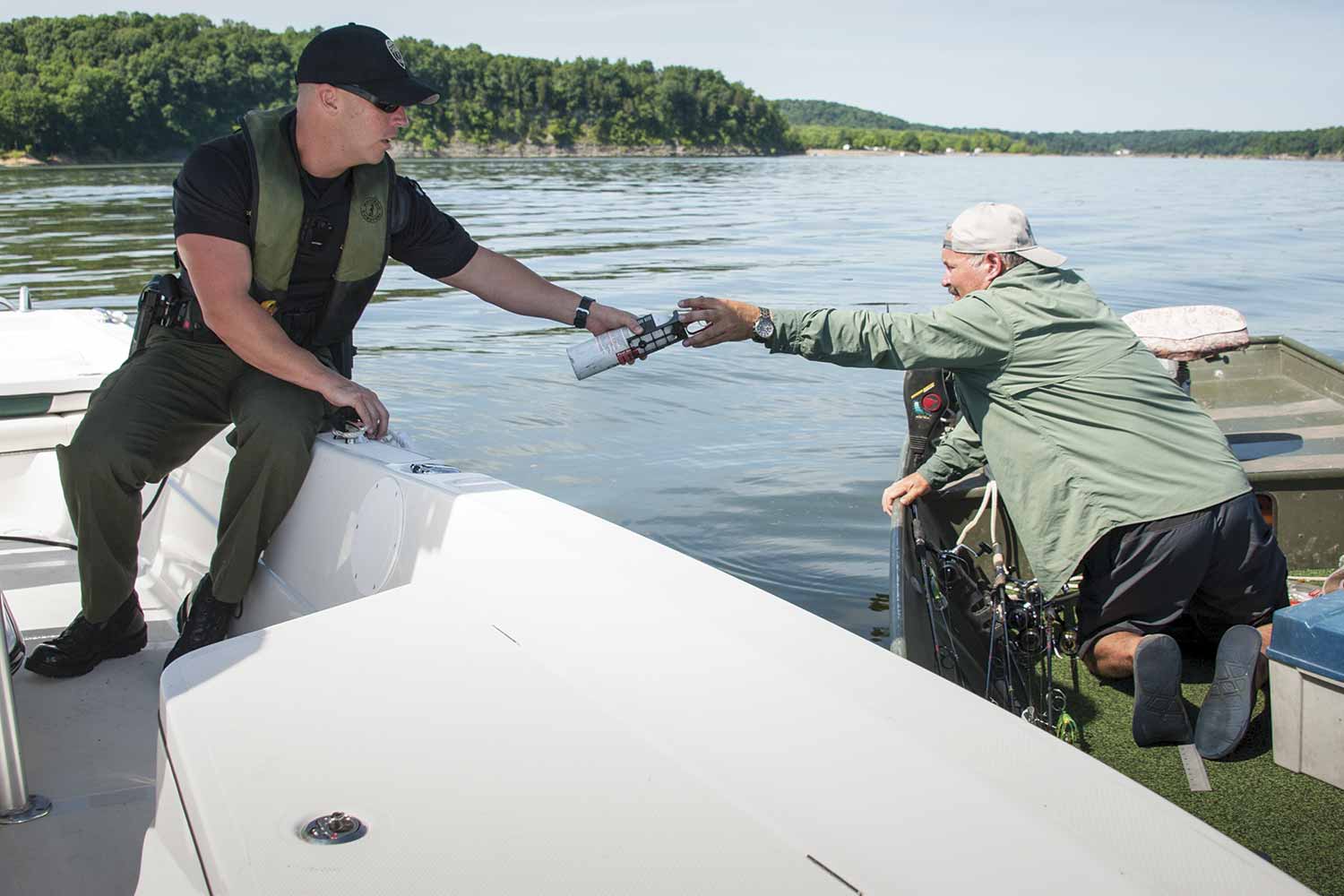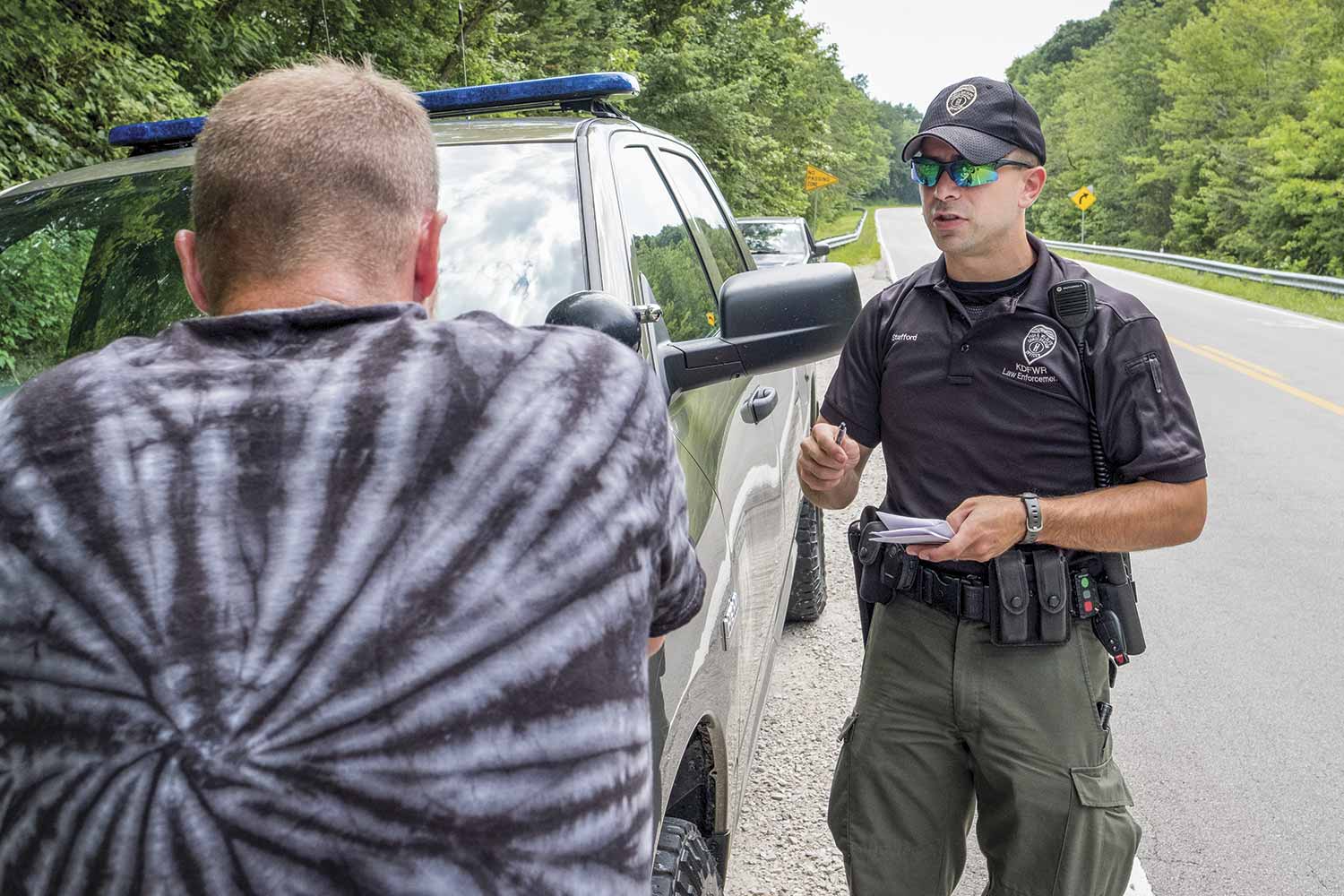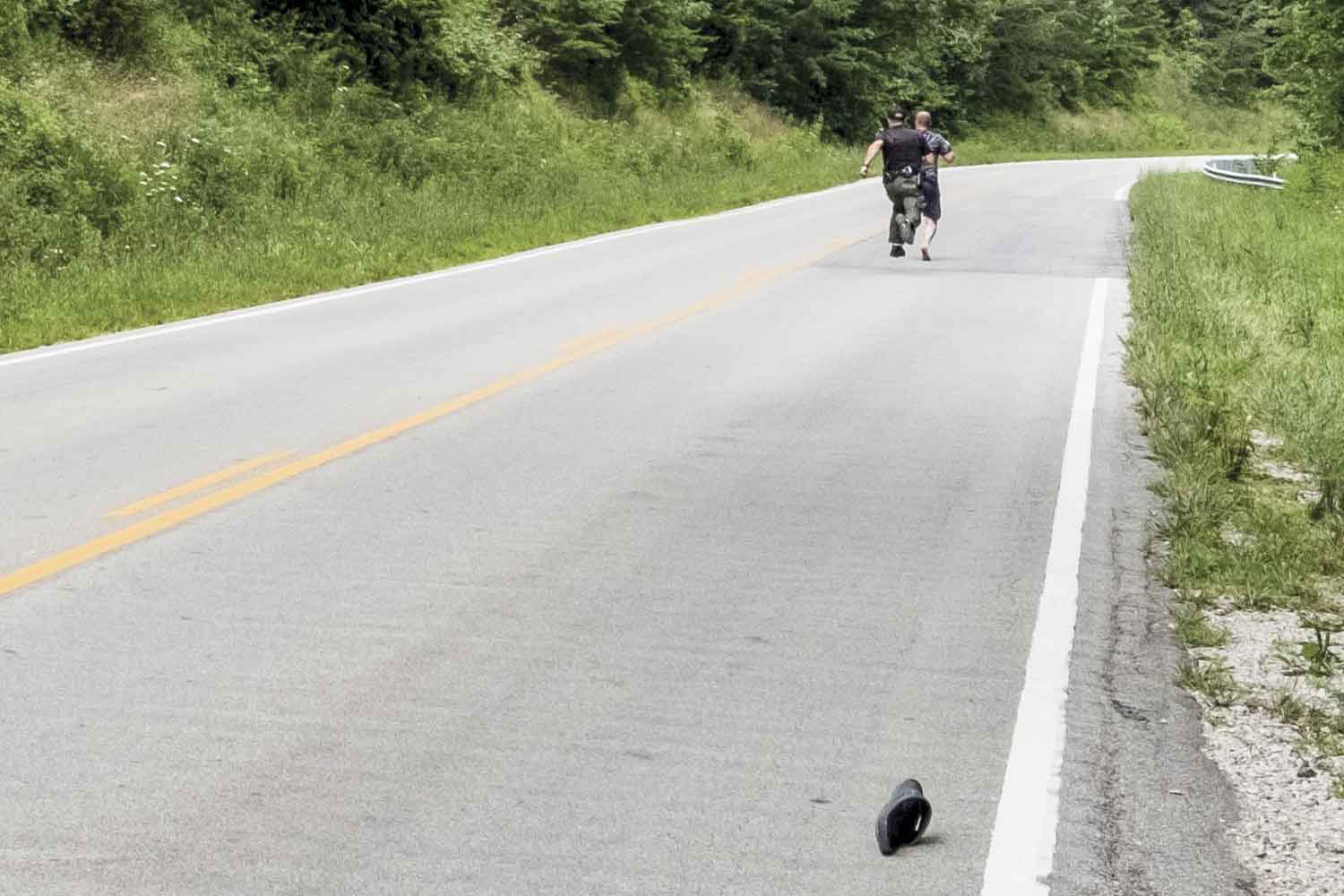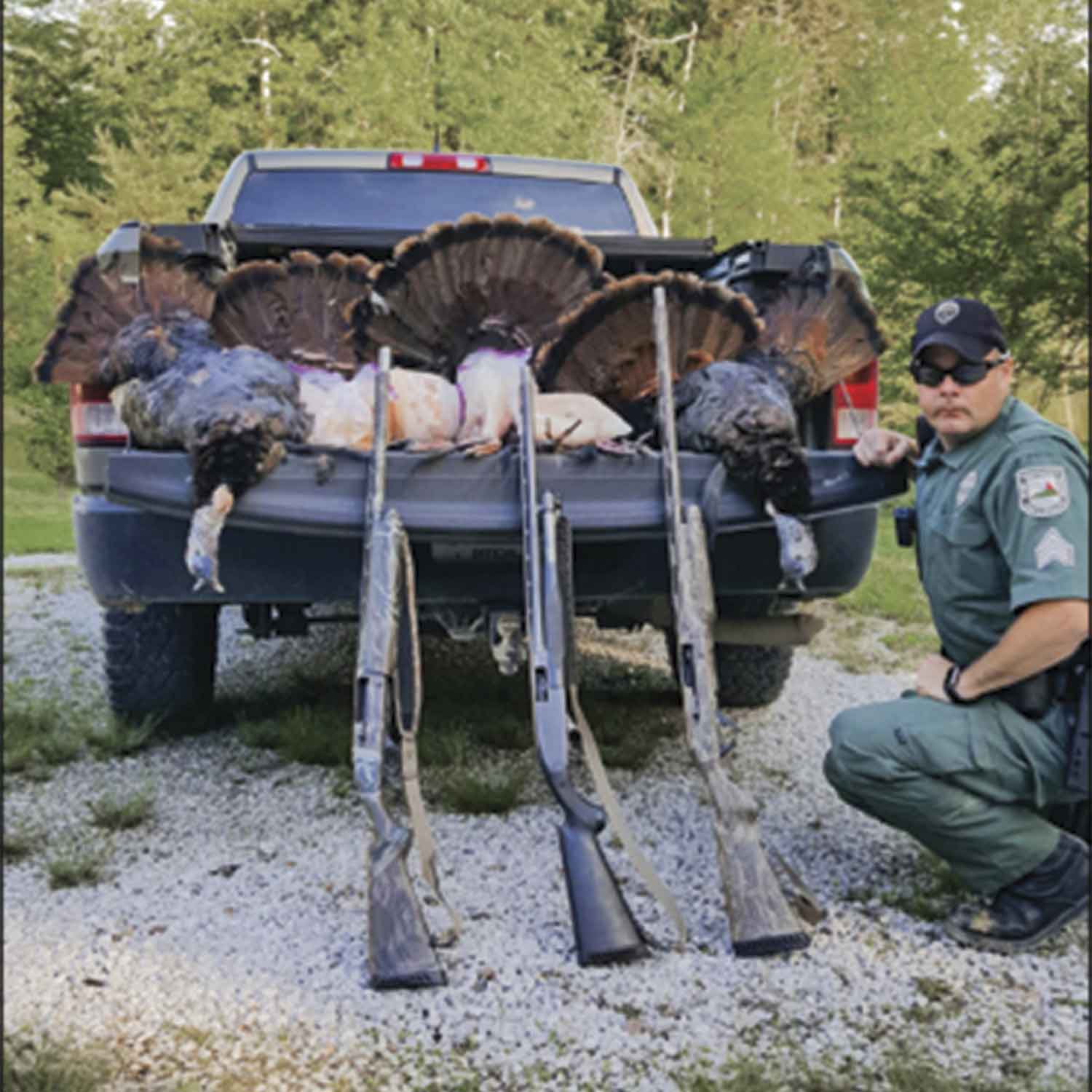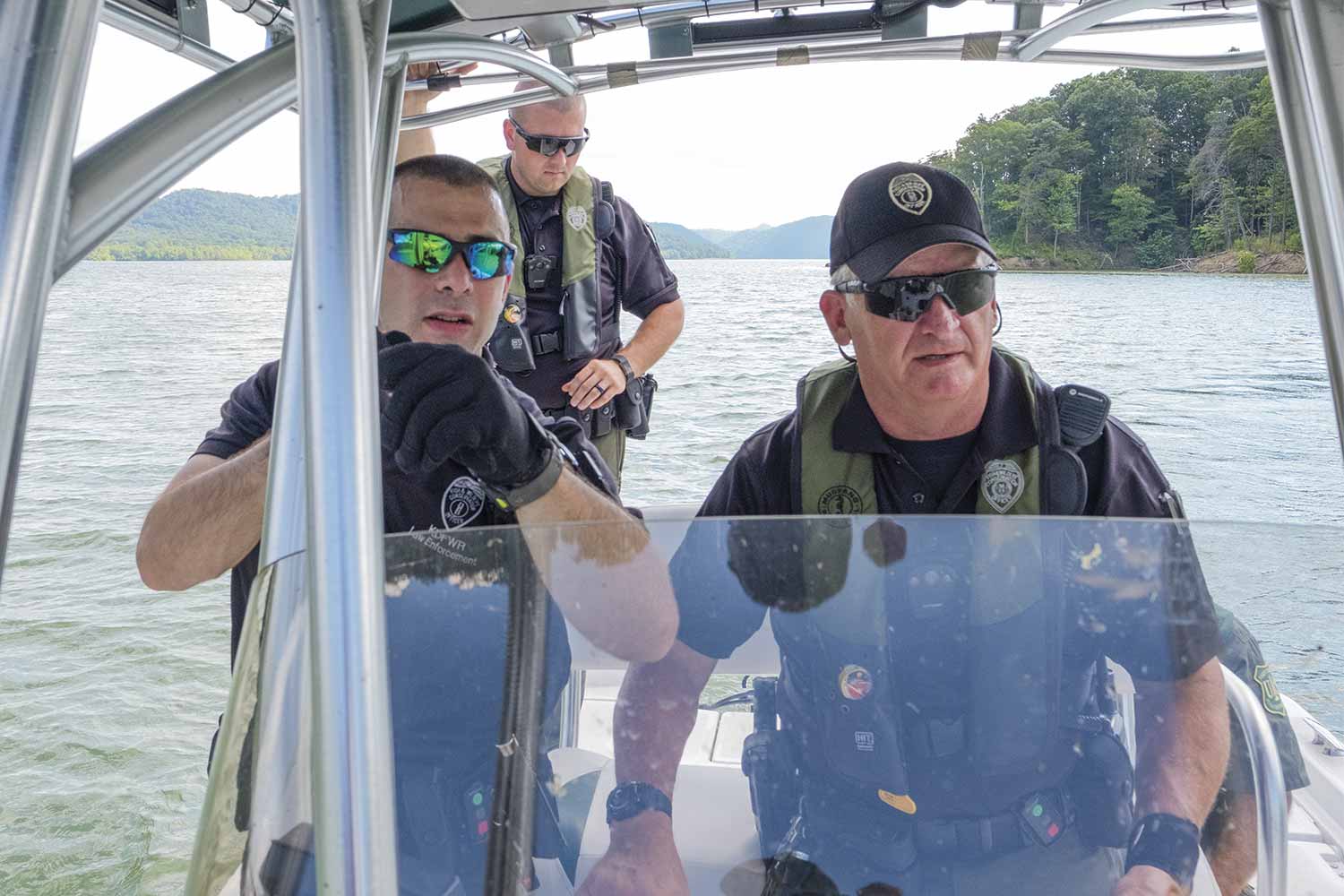Fish and Wildlife
Long associated with issuing hunting and fishing licenses, the Kentucky Department of Fish and Wildlife Resources conservation officers are no strangers to laying down the law – all of Kentucky’s laws.
According to the KDFWR 2016 Year End Activity summary, conservation officers were involved in 45 drug-related arrests, while issuing another 154 drug-related citations. Those officers served 262 arrest warrants and participated in 433 search-and-rescue incidents. That’s on top of the 7,030 citations written for hunting, fishing and boating infractions and 111 arrests for boating under the influence.
The 2016 numbers are proof the 129 conservation officers do much more than serve as game wardens to Kentucky’s more than 2 million acres of public hunting lands and waterways.
Scope of the Job
Conservation officers typically go places where other law enforcement agencies are not patrolling.
“For instance, we’re the only law enforcement on the water,” Muhlenberg County-based Sgt. Scott McIntosh said.
Kentucky has more navigable miles of water than any other state in the union, other than Alaska. According to KDFWR, the state has more than 210,126 acres of waterway along the Ohio and Mississippi rivers. In addition, the state boasts 227,908 acres of lakes and more than 10,000 miles of streams, which keeps conservation officers busy year round.
“We have to enforce all of the laws of the commonwealth while focusing on hunting, fishing and boating laws,” McIntosh, a 13-year veteran said.
To illustrate his point, McIntosh recalled an incident, which happened in late May.
“I was on my way home, and this car turns on the main road in front of me and just stops,” McIntosh said. “I hit the brakes and everything in my truck was on the floorboard. I pulled him over, and the guy has all kinds of weed. He was smoking weed, and he had two big bundles of cash, scales and all of this crap. So, I made the arrest.”
Rowan County Conservation Officer Brad Stafford said the job also requires both a love for the outdoors and tolerances for Mother Nature because oftentimes, he finds himself on foot.
“On any given day, I can be miles from my truck looking for anything from a squirrel hunter to a marijuana field,” he said. “You must enjoy the outdoors and the challenges and benefits associated with working in the fields, forests, streams, lakes and rivers.”
The job also requires an officer to be a self-starter, Lt. Jeremy McQueary, with 4th District in south-central Kentucky, said.
“You’re more proactive,” the 10-year veteran said. “You’re also out looking and talking to people to develop cases.”
Conservation officers do not receive many calls, McQueary said. They rely more on their intuition and interview and investigative skills. When he was a Kentucky Park Ranger, he performed more traditional police work.
“The calls were coming to me, so I was reacting to them,” he said. “With fish and wildlife, the majority of the work is proactive.”
Lt. Jeremy McQueary performs a boating compliance check on the Green River Lake. McQueary said KDFWR officers spend a lot of time on the water between Memorial and Labor days. (Photo by Jim Robertson)
War on Drugs
If one works in law enforcement, they know all too well the drug problem facing the state, and conservation officers are no different.
“Those people who sell and produce meth and push pills, they hunt, they fish, and they enjoy our lakes, too,” McQueary said. “The problem is ever evolving for us. Take the Green River Lake for example; 22,000 land acres surround it, which is open to the public. There is no better place to go either cook meth, sell drugs or use drugs than a place like that. So on any given day, I may come up on somebody and that is what they’re doing. It happened at the other end of the lake over the past two weeks.”
McIntosh said many times, he might be looking for something completely unrelated to drugs and stumble across drug use.
“On June 25 we had a meth bust in the Peabody Wildlife Management Area in Muhlenberg County,” he said. “We got a tip on social media of a possible dump site, and when we got to the area, we saw a pickup truck illegally parked off the roadway. We found a male and female in the truck smoking meth. They had a few bags of crystal meth, probably about two grams.”
Whether it’s drugs or thefts, oftentimes KDFWR officers work together with other agencies.
Backup
On a warm, muggy late June afternoon, Stafford was conducting compliance checks along the banks of Cave Run Lake near Morehead when he came across a man, his girlfriend and her three small children fishing near a cove.
During the check, the suspect – Gary Hogston – broke free from Stafford, and a foot chase ensued. During the chase, Stafford called for backup. Within minutes, additional KDFWR officers, who were helping patrol the lake during a busy time, along with Kentucky State Police troopers and Morehead Police Department officers were on scene.
During the chase, Stafford slipped on a muddy embankment, which allowed Hogston an advantage as he jumped into the water and swam to the other side of the cove. Officers, aided by a tracking dog courtesy of an officer with a U.S. Forest Service, searched the wooded area for several hours before calling it off once the canine lost the trail along the roadway. A few hours later, Morehead police apprehended Hogston at his home as he packed to allegedly leave the area. Stafford said he offered no resistance at the time of his arrest.
“His feet and legs were chewed up from running barefoot through the woods, so he didn’t want anymore,” Stafford said. “He apparently ran through the woods for five or more miles and then thumbed a ride back to Morehead.”
Stafford said that incident is a prime example of law enforcement agencies working together for the common goal of public safety.
“Due to having only one conservation officer per county, multi-agency cooperation is vital to how we work,” Stafford said. “Whether we wear black, green, gray, tan or blue, we’re all on the same team and have the same objective.”
Many times, conservation officers are alone, and the nearest KDFWR backup can be several counties away. A healthy relationship with sheriff’s offices, police departments and other public safety agencies is necessary.
KDFWR has broken down the state into nine law enforcement districts. The number of counties in each district range from seven to 16, and are patrolled by the agency’s 129 officers, so many times, they are a long way from other KDFWR officers.
“We need these relationships,” McIntosh said. “We are out here by ourselves, generally speaking. My backup will most likely be one of those people. If one of us needs something, we can have conservation officers on their way within minutes, but the closest one might be more than an hour away. These people are hopefully minutes away. And if they need help, I will go to them.”
McQueary agreed.
“In this area, state police, sheriff’s office, park rangers … we need their help,” McQueary said. “We also need it with all rescue agencies. They help us tremendously on the lake. If we have a drowning, or if we have someone hurt on the lake, they are the only [other] people who have boats and the training to help us.”
Many conservation officers do not enjoy the luxury of a physical building to do their paperwork. Their office is the four-wheel drive truck they use, McQueary said.
“It has its pros and cons,” he said. “The benefit is you have everything you need in one small place. The con is many times we battle Internet and storage issues.”
McQueary said solid relationships with other agencies come in handy with this issue, too.
“We will stop at a police department or sheriff’s office we might not have been to in a month and sit down and use their desks or their Wi-Fi,” he said. “That’s where building those relationships come into play.”
Poachers
McIntosh said there is no down time. Once one season ends, another begins.
Typically, the water season runs from Memorial Day to Labor Day. During that time, McIntosh said many hours are spent on the water enforcing boating laws and compliance checks for fishing and boating.
After Labor Day, the hunting season dominates as deer, turkey, dove and goose seasons all begin around the same time.
Sgt. Scott McIntosh posed with several turkeys after making illegal taking arrests in the spring. (PHOTO PROVIDED)
“We have Labor Day on the water, but at the same time, dove season is kicking off,” McIntosh said. “There is deer season running from September through January. Then you’re right in the middle of duck season, and when it ends, you have people who are trapping. Then it’s turkey season in April. We have the youth turkey season which begins a few weeks before the main season.”
McIntosh said turkey season is also the high mark for illegal taking, also known as poaching, in the state.
“That’s because you’re in full cammo, you’re out in the woods, the foliage is on, and so for us, it’s harder to detect,” he said. “I know we do a good job of catching people, but I know in my heart we’re only getting a fraction of those who are out there doing it.”
Illegal taking is problematic statewide, Stafford said, and often, poaching leads to other violations.
“The biggest thing I’ve noticed is the lack of respect some people have for the rights of property owners,” he said. “Trespassing, coming on the land with the
intent to hunt without permission are some of the most common complaints I get from landowners. Spotlighting complaints typically start as early as July and August. That’s because the bucks are starting to get noticeable antler growth by then, so poachers are scouting the county to get an idea on where the “big ones” will be in the fall.”
Conservation officer Brad Stafford, front, left, Sgt. Glenn Kitchen, front, right, and conservation officer Christopher Carson took to the waters of Cave Run Lake to search for Gary Hogston after the suspect eluded capture earlier in the day. (Photo by Jim Robertson)
Training
Like other members of Kentucky’s law enforcement community, KDFWR conservation officers go through a 23-week basic training at the Department of Criminal Justice Training in Richmond. Following DOCJT, conservation officers have an additional 12 weeks of Fish and Wildlife Academy training, followed by 16 weeks of field training.
“You’re talking 51 weeks of training before a conservation officer is turned loose on their own,” McIntosh said.
The Fish and Wildlife Academy reinforces much of the training received at DOCJT, including firearms and defensive tactics. It also features training specific to a conservation officer, in areas such as all-terrain vehicles, waterfowl training, water survival, fish identification and wildlife forensics.
McQueary said the water-survival training has significant importance, given all conservation officers spend a great deal of time on the water.
“You’re in full gear for five days, and you learn how to survive if you were to get into a fight in the water,” he said.
McIntosh added the water-survival training probably was the most challenging part of the training he received.
“That was the hardest week of my life, both mentally and physically,” he said. “That being said, it was the best training I’ve ever had in my law enforcement career.”
To pass water-survival training, officers complete a 100-yard swim, while wearing full uniform, using any combination of freestyle, breaststroke or sidestroke. Additionally, officers must tread water with their earlobes above the surface for 10 minutes while in full uniform.
“That is on top of the POPS (Peace Officer Professional Standards) test,” McIntosh said.
Sgt. Scott McIntosh places a Covert Code Black cell phone camera on a tree in the Peabody Wildlife Management Area. The device is used by McIntosh to monitor activity in the immediate area. It allows McIntosh the freedom to move from spot-to-spot and cast a wider net as photos from the device are sent to his cell phone. (Photo by Jim Robertson)
Educating the Public
The agency dedicates a significant portion of its budget in the area of educating the public, McIntosh said. It is common to find conservation officers in schools and speaking to civic groups about Kentucky wildlife.
“We educate the public with pamphlets, hunting guides, fishing guides and boating guides,” McIntosh said. “We also do programs, where we speak to civic organizations and schools. I do two programs a month, sometimes more. I enjoy finding somebody who doesn’t know what we do and educating them.”
McQueary said education is vital, especially among children.
“They are the future of the sport of hunting, fishing and boating,” he said. “We need to make sure we introduce them to the outdoors, so we spend a ton of time at schools and kids’ programs.”
Conservation officer Lee Keith shows off animal skins to some children during the Green River Lake Kids Day held on June 3. (Photo by Jim Robertson)
Unique way of life
The life of a Kentucky Department of Fish and Wildlife Resources conservation officer is different, McQueary said.
“You can be out on a dove field, and what we call a low bird flies in and the hunter shoots, and you’re getting hit in the face with shot – the pellets,” McQueary said, shaking his head. “I’ve been hit more than once. They are not trying to hurt you, but these are just day-to-day issues we face that you may not see in general law enforcement. If I were a city police officer and somebody did that, it’s a different ball game because the intent is different, most of the time.”
McQueary said conservation officers also encounter novice hunters who don’t know proper gun etiquette.
“You walk up and do your introduction, and they stand to talk to you, and your face is this far (gesturing a few inches) from the end of a rifle, shotgun or pistol,” McQueary said. “We’ve all had it happen to us.”
Mostly, for those in KDFWR, it’s a labor of two loves, Stafford said.
“I jokingly tell people when I found out I could work in law enforcement, wear boots and drive a truck, I had found my niche,” he said. “I love being outdoors and the fact my truck is my office only makes the job better.”

